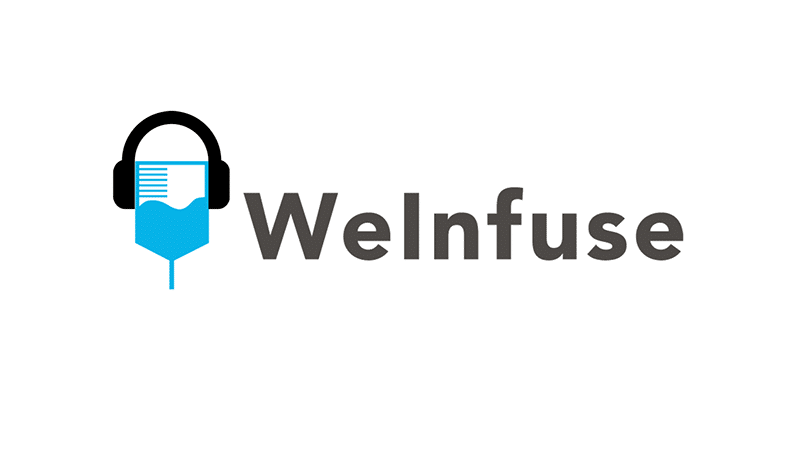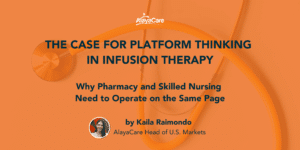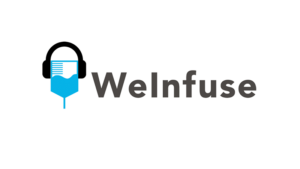Roger Massengale, Chief Commercial Officer of Eitan Medical, shares how innovation, technology, data, interoperability, connectivity, and embracing change can improve the caregiver and patient experience.
Follow on Amazon Music II Subscribe to Podbean II Subscribe to iTunes
Transcript: How Innovation and Technology Can Improve Care
Amanda Brummitt: We Infuse podcast, episode number 52. Welcome to the We Infuse podcast. My name is Amanda Bremit. In every episode, we give you a seat at the table as we talk to Infusion Center owners, operators, and experts so that you can get the insight you need to run a thriving practice. In this episode, we talk with Roger Massengill, chief commercial officer of Aton Medical. Roger has all kinds of great information on innovation, technology. data, interoperability, implementing change, and successfully improving the caregiver and patient experience. Well, Roger, thank you so much for being here with us. I know that our listeners are all super excited to hear about your fascinating journey in infusion, and I’d love for you to actually just start out by giving our listeners your background and how you got into the infusion space.
Roger Massengale: Okay. Thank you, for the opportunity to talk to you. I, it’s a little bit of an unusual path. I, started in aerospace and, that was my education background. quickly moved, from there to automotive and, spend a little time there. and then, after, tours of duty in those two industries decided that I wanted to get into medical because it’s a lot more stable. it was a growing industry, of course. And, the other thing is you get to help people, recover from illness or injury. And that makes it a lot easier to get passionate about what you do. and, so I made that jump in, I don’t know, it was 1990 or so. but, but it’s been a great ride. Really, enjoying the medical device world. it’s been a lot of fun.
Amanda Brummitt: Yeah. So from engineer to medical device guy, I think it’s a big jump, but it’s not that big. I could see how it really works and probably makes you very good at what you do.
Roger Massengale: I don’t know about it. I don’t know about that, but thanks for that.
Amanda Brummitt: What would you say is your biggest area of expertise within the field?
Roger Massengale: That’s a difficult question to answer because I’ve had so many different roles and, you’ve heard the phrase, jack of all trades, master of none. I’ve, had quite a number of roles from, R and D obviously, and manufacturing to clinical to marketing, business development, et cetera. But I think, I’m really right now, just lucky to work with a very talented group of people, in, in, on my team. They have very, diverse backgrounds like myself as well. Well, I lead the commercial team here at Aton. most of the people that I work with come from backgrounds like clinical, some in sales, some in marketing, some in operations. So a lot of people have R and D or engineering backgrounds too. So it’s, it’s a lot of fun to work with people with such diverse backgrounds, because they can bring a lot of, expertise and opinions to, to how we practice, our business and, watch products and, help customers. it’s been a lot of fun.
Amanda Brummitt: Yeah, that really brings new meaning to a multidisciplinary team. love that, especially when it comes to healthcare technology, for sure. So if there was one thing that you’d want our listeners to learn from your vast background, what, would it be?
Roger Massengale: I would say, I came to this company really in part because, the team here, is just incredible. it’s a really talented group of, engineers, and like I said, clinicians. but we all share kind of the belief that innovation is super important to success. And, we believe that, you just can’t launch a product and just, run with, that product forever. You’ve got to be able to innovate, after you launch the product and continually improve it. And, we’re lucky enough in this position, I think, to be able to work directly with clinicians, and we can see what their pain points are, and sometimes they can’t express those pain points, in technological solutions, but, if you’re working with them closely, and you’re listening to them, and you’re asking them questions, you can design, solutions or products to, to make their world easier, and, And I think making a clinician life, easier patient, life easier and safer, is ultimately what we’re here for. And it’s, it’s what we’re passionate about.
Amanda Brummitt: Absolutely. Yeah. I love that you bring that back to the patient. I think we all get. so entrenched in our day to day operations and making sure everything’s running smoothly. And it’s so good to pause and remember that we all show up to do this every day. So the patients have a really smooth experience. and a lot of times that is taking care of our team and making all of that easy. so as I, was hearing you talk about innovation and technology and not just throwing it out there, but throwing it out there and then improving it, it sounds a little bit like. Brian and Reese over at we infuse. so it does make me curious. How, do you work with them? How, did that, happen?
Roger Massengale: We, we were in, I was introduced to, to them at, by a distributor partner of ours who had invited them to speak at a, conference or a sales meeting, I think it was, and, immediately, became, Really attracted to their passion for infusion. unbelievably smart people, and passionate about innovation and passionate about, solving problems for customers in the infusion market, and they have such an incredible expertise about how infusion therapy is delivered and both in, in the home and infusion suites. And those are areas that we focus. And so, we hit it off immediately. our teams, had quite a few meetings and still do. trying to learn from them about, what the struggles of their, customers are and how they’re, designing products to, to, solve problems for their customers. And then, we have a, a dream of, integrating our systems to their systems and, and just making it easier for our clinicians to care for patients. And that’s, why we got, got in touch with them. It’s been a great ride so far.
Amanda Brummitt: Yeah. Oh, that’s fantastic. So I know that everybody I’ve talked to in this space, they’ve run into stumbling blocks, struggles. It’s challenging. can you share a story with us about a behind the scenes look at, somewhere where you saw people struggle or you struggled in the infusion space?
Roger Massengale: I could go on for hours on this, but, there’s, this segment of the medical device world is, I gotta say, it’s incredibly challenging. and I think it’s because everything that we do impacts patient safety and satisfaction, which are super critical, of course. And, there are a lot of competitors that have come and gone in this market segment because they’ve struggled to keep their products on the market and, and much less innovate or improve their products. I, I think, implementing change in medical practices is super difficult and resisting change is very, natural and competent. I would say very common in medical. I’ve been fortunate enough to introduce products and technologies, a lot of them in my career and some of which have been very successful. we probably talked about earlier, but, I would say some common attributes in, successful, products. number one is listening to customer feedback and, Not stopping after you’ve launched the product, but maybe in some ways more intently listening to customer feedback after it’s in the market and implementing changes because no product is perfect. And so you’ve got to be willing to adapt the product to the feedback that you’re getting as they’re using it. You’ll get a lot of feedback when you launch a brand new product. And, in some companies, say, look, we spent our money, launching the product. We really don’t have much of a budget or a team to implement changes after it’s out there. Well, that’s, the wrong attitude. So I think having a long term view and a commitment to the product and the technology, is super important, because it can take many years to change practice. you can’t expect immediate wins and you got to be committed for the long run. And so, I don’t know if that’s a, that’s an answer to your question, but that’s what came to mind.
Amanda Brummitt: Yeah, no, that’s a great answer. I see that all the time with technology solutions. And I think especially, I don’t know that we got specifically got into it, but the pumps or what, what your company is working with that, something like that, it needs to be a long term strategy. And, you can’t just, you can’t just roll it out on day one and expect everything to work perfectly. There’s a lot of training and development. And so I love that, that you tell people to prepare that, for any technology that they roll out.
Roger Massengale: Yeah, I know. there’s, like I said, natural resistance to implementation of any new technology because it takes time to implement and we all know there’s a nursing shortage and, and really a labor shortage in every aspect of, of, care, and across every industry right now. it’s a real problem. And so if, what you’re introducing takes time and effort, to implement it, it’s, going to be resistant. So, we’ve got to make our, we’ve got to make the job of the caregiver and the patient easier. That’s, really key. And infusion pumps are, they’re a challenge. They’re, a lot of patients don’t really want to be on an infusion pump and naturally, so, and, but they need them, and the medications we deliver are super critical. So, but we just got to make it easier. We’re just going to make their job easier. And technology, I think can do that if you’re willing to innovate and constantly listen to caregivers, give you feedback.
Amanda Brummitt: So diving just a little deeper into the exact same topic. Are there things that you’ve seen people do really well on the implementation and that you think could parlay into other centers?
Roger Massengale: So one of the things we did as a result of COVID and, again, I’m not, trumpeting our success, but we’ve had a lot of success in the last few years, particularly so, but, but I think it worked out well as a result of COVID was, Finding ways to put tools, education tools online and, and, learning modules and giving nurses the ability to learn at their own pace and own time. And, and I think that’s super important. And the other thing we’ve done is pump simulators, where you could simulate the use of the device, but do that on a PC. And, I think those have been successful. But the other thing is just be willing to come in and, Work through difficult challenges and, and support them. We would like to say we will run through brick walls for our customers. because that’s our lifeblood and if we don’t have customers, we don’t have a business, so, we’ll do whatever it takes to make them happy. And, I think a lot of companies that do that well, obviously earn the trust of their customers and they get long term business out of it, and that’s what it’s all about.
Amanda Brummitt: Absolutely, for sure. So what would you say through all your experiences in Infusion, what’s been your biggest light bulb moment that you can share with owners and operators?
Roger Massengale: let’s see, I maybe an infusion therapy specific to medical, the infusion therapy world that I’ve been living in for the last 30 years or so. I would say we’re way behind in innovation. I have a F 1 50 and when I drive my truck into the garage, it automatically updates the software and it sends me notifications on an app that I have and everything in my home is connected to the Internet. Almost everything. So, my AC, my stereo, my security system, of course, but in the medical device world, so few things are connected. And, and it’s in part because companies have had struggles to try and keep their product on the market, number one, and number two, innovate. and, and, so the technology certainly exists out there, but, companies have not connected their systems to the, to, to, the hospital information system or the ambulatory infusion center information system that’s just not connected through the internet, which is dumb, because the medications we deliver are very, expensive. In some cases, incredibly expensive. And it’s natural for payers and physicians when they prescribe these medications to, to, want to know that they’re making a difference for the patient. is it safe for patients having reactions? are they getting good outcomes? Are they improving? Right. And, And so I think the lightbulb moment for us was realizing that this is not an option anymore. We’ve got to connect everything we do to the internet and we’re going to make that data available to the people that need it. Right. So, so the physician, the patient, the caregivers, the nurse, the pharmacist, et cetera, in our industry, we’ve just got to make that data available. And data is, it’s not an option. it’s, got to be It’s got to be simple and it’s got to be automated. and like I said earlier, there’s a severe nurse shortage. And so we really don’t have a lot of time for nurses to be writing, outcomes on a piece of paper and then typing that into a system and EMR system, and, then mining that data for some sort of insight. We’ve got to make it much, much simpler for nurses and caregivers to. Find out, is the patient taking the medication properly? Are they getting the good, the outcomes that they expect? are there complications or issues with the infusion that need to be addressed? And focusing on those patients who are having issues as opposed to those that, that are doing well, allocating the labor to the right, right spot. I think it’s really important. anyway, so, so the light bulb is, data connectivity, not an option. It’s got to happen. And it’s, about time, in the infusion industry to make sure that happens outside the hospital. Obviously we know what happens inside the hospital, but not generally outside the hospital and infusion suites are all
Amanda Brummitt: right. I totally agree. Roger. 2022, we’re still talking about this. That we’ve been talking about interoperability for 30 years now in health care. so I’m ecstatic to hear that you guys are doing it and making it possible for, the folks that are using your products. And we’ve all got to work harder on that, to make it easier for the patients, easier for the staff. And, it’s just better. It’s such a missed opportunity when you’ve got the technology and you don’t use it. Well, shifting gears. Tell me what you are most excited about right now in the infusion industry, in what you’re doing, And anything in that space?
Roger Massengale: Well, we have, like I said, we’ve had great success with the Sapphire infusion system. we’ve, really gone, at light speed. It’s, been crazy since, just before COVID and then, through COVID. we’ve just been very fortunate and, and so we’re super excited about some of the innovations that we’re bringing to bear on, on, on that system. and we’re launching a little bit later this year, something called Aton Insights, which is connecting our system to, to a dashboard of insights that will help healthcare provider manage the infusion better. and in the home it’s particularly important, there’s a lot of patients who are treated at home. you’d be shocked, but a lot of these patients lose the infusion pumps and the statistics that we, have found anywhere between five and 20 percent of infusion pumps get lost each year, which is crazy. and these are not, inexpensive assets. And so, I don’t know about you, but I use my iPhone to know what my kids are doing. Right. And something go find my iPhone is a stupid, simple technology. And. And, or if I misplaced my AirPods or something, I can in seconds figure out where the last, time this thing was used. And, so we’re bringing that technology to infusion pumps. And so we’re going to, and we’re going to give that insight to, to our providers where they can know where the pumps are, where they were last in essence, where they were last used. And then more importantly, give them a data on how they’re performing and, Whether or not the patient’s getting the medication they were supposed to get, and giving them insights. maybe this pump is alarming. You might want to call that patient that sort of thing. And so, all of that data is available in the system today. We just had to come up with a very simple vehicle, a stupid, simple vehicle to make it really easy to see and use. And that’s what we’ve done. So we’re super excited about that. We’ll be launching that a little bit later. this year initially on the Sapphire and then on some other products as well as they get launched. So very excited about that.
Amanda Brummitt: Wow. That is incredible. I, you still, you lost me at infusion pumps get lost. I am shocked.
Roger Massengale: Well, you’d be surprised at where they end up. and I’ll give you one case study. It makes sense. If a patient’s being treated at home and let’s say they have a complication, they have to go to the hospital. They might bring their pump with them to the hospital.
Amanda Brummitt: Okay.
Roger Massengale: So when they, check in at the yard, guess what? The hospital grabs this thing, sticks it in the corner, and they lose it. They don’t know where it is. And, so for the home care provider who paid for that pump, they want it back. And the patient doesn’t really remember they were having an event, and that, and their family member might not remember. So that’s a pretty common, issue, but yeah, five to 20 percent of these pumps get lost each year. It’s crazy.
Amanda Brummitt: Wow. Amazing. Amazing. Well, I love the way that you guys are integrating all that technology and getting that real time data back to the folks that need it. That is fantastic. Well, Roger, you have been a wealth of information on lots of different things. I, I feel like you’ve really inspired us all to do a better job, with our technology and interoperability. Is there one last piece of advice that you can give to our listeners? I
Roger Massengale: guess I would say be open to change. we’ve all moved from dumb flip phones with nine or 10 buttons, or I don’t know how many buttons a flip phone has, but small number of buttons that, they’re just stupid devices. We moved pretty quickly to smartphones because it made our lives easier. But if you go back and you look at how different our lives are, because of what power we have in our pocket with that phone, a smartphone, it really has been a remarkable change. And so. Being open to making that change is super important. And in, in medicine, I think we need to make that same shift. And that’s what we’re trying to do at Aton is, give smart devices to people that are connected that allow them to learn more about the patient and what’s going on with that therapy. and, if you’re open to it and you’re willing to take A little bit of pain and making that transition. we’re confident that your life will be a lot easier and a lot more efficient in the future and cost of care will go down patient satisfaction will go up. We hope patient safety will be improved as well. So that’s the dream.
Amanda Brummitt: Fantastic. Really appreciate that. thank you for all that you’ve done to drive technology forward in the industry. And thank you for your partnership with Weanviews.
Roger Massengale: Okay. Thank you very much. Appreciate the time.
Amanda Brummitt: Wow. I don’t know about you, but Roger really got me pumped up about implementing technology, interoperability, data, and being open to change. Roger had such great advice on how to do technology right, and the benefits for caregivers and patients are clear. Speaking of technology, if you aren’t familiar with the WeInfuse software platform, I encourage you to schedule a test drive to see how they can save you time and money in your practice. My name is Amanda Brummett, and we’ll catch you in the next episode.
Guest Speaker:
Roger Massengale serves as Chief Commercial Officer at Eitan Medical. With over 20 years of experience, Roger was the VP of Avanos Medical and General Manager of multiple acute pain healthcare businesses. He was the VP for Business Development, Marketing & Clinical Research at I-Flow, and co-wrote the ISO standards for disposable infusion pumps.




